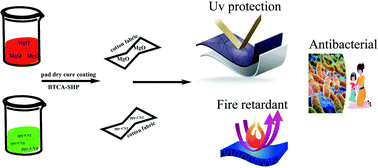Synthesis of ppy–MgO–CNT nanocomposites for multifunctional applications†
Abstract
Cotton is one of the most important raw materials for textile and clothing production. The main drawbacks of cotton fibers are their poor mechanical properties and high flammability. Compared with some synthetic polymer fibers, cotton fabrics treated with modern flame-retardant and reinforcement finishes often cannot meet rigid military specifications. Polypyrrole–magnesium oxide (ppy–MgO) and polypyrrole–magnesium oxide–carbon nanotube (ppy–MgO–CNT) composites were prepared with various weight ratios by in situ chemical polymerization method. 1,2,3,4-Butane tetracarboxylic acid (BTCA) was used as a cross-linking agent in the presence of sodium hypophosphite (SHP). The composite sol was coated on cotton fabric using the pad-dry-cure technique. The coated cotton fabrics were characterized by SEM, EDAX, XRD, UV-DRS and FT-IR analysis, and tested for flame retardant and UPF application. The flame-retardant study showed a maximum char length of 0.3 cm and the char yield was about 49% for the ppy–MgO–CNT composite. For that UPF application, a 30 UPF value was shown for the ppy–MgO–CNT composite. In the case of the antibacterial study, the zone of inhibition was observed for all of the test samples against MRSA and PAO1 bacteria. The zone of inhibition showed as 4.0, 3.0 mm for the ppy–MgO–CNT composite. Hence, the ppy–MgO–CNT composite was found to be efficient.



 Please wait while we load your content...
Please wait while we load your content...